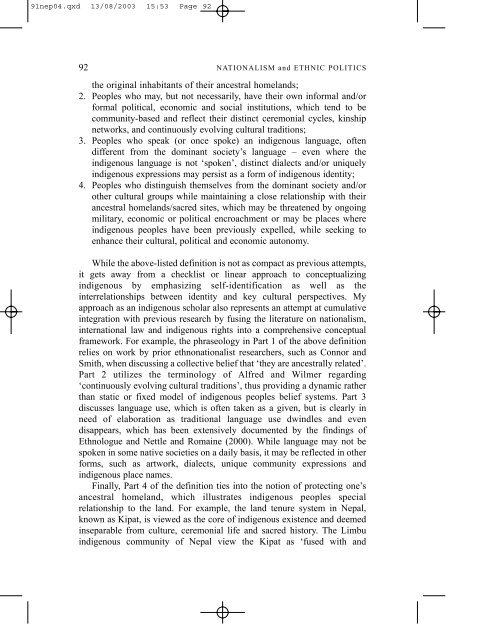Who is Indigenous? 'Peoplehood' and Ethnonationalist Approaches to Rearticulating Indigenous Identity
by Jeff J. Corntassel
by Jeff J. Corntassel
Create successful ePaper yourself
Turn your PDF publications into a flip-book with our unique Google optimized e-Paper software.
91nep04.qxd 13/08/2003 15:53 Page 92<br />
92 NATIONALISM <strong>and</strong> ETHNIC POLITICS<br />
the original inhabitants of their ancestral homel<strong>and</strong>s;<br />
2. Peoples who may, but not necessarily, have their own informal <strong>and</strong>/or<br />
formal political, economic <strong>and</strong> social institutions, which tend <strong>to</strong> be<br />
community-based <strong>and</strong> reflect their d<strong>is</strong>tinct ceremonial cycles, kinship<br />
networks, <strong>and</strong> continuously evolving cultural traditions;<br />
3. Peoples who speak (or once spoke) an indigenous language, often<br />
different from the dominant society’s language – even where the<br />
indigenous language <strong>is</strong> not ‘spoken’, d<strong>is</strong>tinct dialects <strong>and</strong>/or uniquely<br />
indigenous expressions may pers<strong>is</strong>t as a form of indigenous identity;<br />
4. Peoples who d<strong>is</strong>tingu<strong>is</strong>h themselves from the dominant society <strong>and</strong>/or<br />
other cultural groups while maintaining a close relationship with their<br />
ancestral homel<strong>and</strong>s/sacred sites, which may be threatened by ongoing<br />
military, economic or political encroachment or may be places where<br />
indigenous peoples have been previously expelled, while seeking <strong>to</strong><br />
enhance their cultural, political <strong>and</strong> economic au<strong>to</strong>nomy.<br />
While the above-l<strong>is</strong>ted definition <strong>is</strong> not as compact as previous attempts,<br />
it gets away from a checkl<strong>is</strong>t or linear approach <strong>to</strong> conceptualizing<br />
indigenous by emphasizing self-identification as well as the<br />
interrelationships between identity <strong>and</strong> key cultural perspectives. My<br />
approach as an indigenous scholar also represents an attempt at cumulative<br />
integration with previous research by fusing the literature on national<strong>is</strong>m,<br />
international law <strong>and</strong> indigenous rights in<strong>to</strong> a comprehensive conceptual<br />
framework. or example, the phraseology in Part 1 of the above definition<br />
relies on work by prior ethnonational<strong>is</strong>t researchers, such as Connor <strong>and</strong><br />
Smith, when d<strong>is</strong>cussing a collective belief that ‘they are ancestrally related’.<br />
Part 2 utilizes the terminology of Alfred <strong>and</strong> Wilmer regarding<br />
‘continuously evolving cultural traditions’, thus providing a dynamic rather<br />
than static or fixed model of indigenous peoples belief systems. Part 3<br />
d<strong>is</strong>cusses language use, which <strong>is</strong> often taken as a given, but <strong>is</strong> clearly in<br />
need of elaboration as traditional language use dwindles <strong>and</strong> even<br />
d<strong>is</strong>appears, which has been extensively documented by the findings of<br />
Ethnologue <strong>and</strong> Nettle <strong>and</strong> Romaine (2000). While language may not be<br />
spoken in some native societies on a daily bas<strong>is</strong>, it may be reflected in other<br />
forms, such as artwork, dialects, unique community expressions <strong>and</strong><br />
indigenous place names.<br />
inally, Part 4 of the definition ties in<strong>to</strong> the notion of protecting one’s<br />
ancestral homel<strong>and</strong>, which illustrates indigenous peoples special<br />
relationship <strong>to</strong> the l<strong>and</strong>. or example, the l<strong>and</strong> tenure system in Nepal,<br />
known as Kipat, <strong>is</strong> viewed as the core of indigenous ex<strong>is</strong>tence <strong>and</strong> deemed<br />
inseparable from culture, ceremonial life <strong>and</strong> sacred h<strong>is</strong><strong>to</strong>ry. The Limbu<br />
indigenous community of Nepal view the Kipat as ‘fused with <strong>and</strong>


















